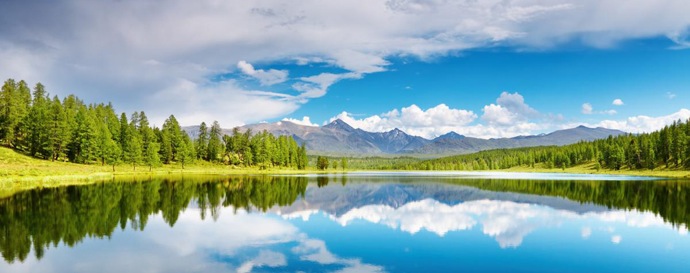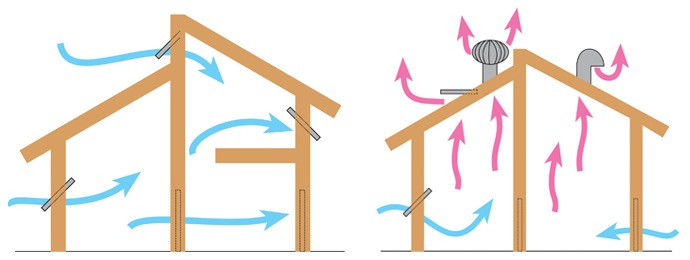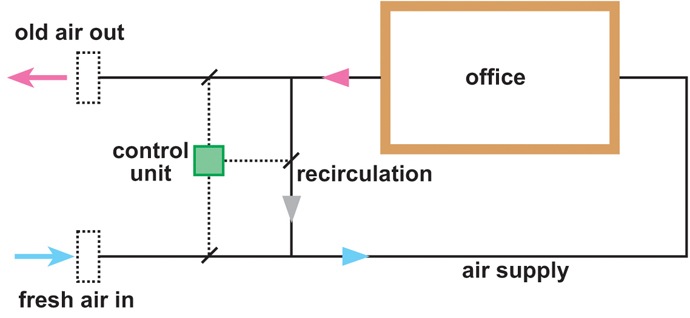All About Insulation and Ventilation for Clean, Fresh Air

We all need fresh air to live, but how can we ensure that there is always fresh, clean air in the buildings that we live and work in? The answer lies in well-designed ventilation systems that are developed by professionals to keep our buildings healthy and safe.
The people who design our buildings have a lot to answer for when it comes to ventilation, heating and cooling. Ventilation relates to the fresh air in our buildings. Heating is what keeps us warm; and cooling is what prevents us from getting too hot. Then there is the insulation that prevents heat from getting in or out of buildings, and stops the cold from entering. Insulation may be in our walls or our floors or ceilings, or even in our glass windows.
Here we are going to focus on ventilation. Think about some of the buildings you have been in, or have lived in. Those that have cold, dark, draughty rooms are uncomfortable to live in and unpleasant to visit. So are those that are stuffy and hot.
South Africa is a country with a varied climate in different parts. This means that architects and designers working in different parts of the country will have different challenges. For example, a building in Durban or Pofadder will need to be cooled, while buildings in Sutherland or Bloemfontein will definitely need heating systems for winter. Central heating is hardly ever a prerequisite for Durban buildings.
There is a lot of science involved when it comes to insulation and ventilation, but as long as contractors do what is asked of them, according to designs and specifications provided to them, they should not experience problems. There is an acronym that is often used in the ventilation industry, HVAC. An acronym is a word formed by the first letters of a name used to describe something. HVAC stands for ‘heating, ventilation and air conditioning’, and it is these elements that control air temperature and humidity.
First we’re going to look at how ventilation is covered in our building regulations, then we’ll look at air conditioning.
The building regulations and ventilation
Ventilation is very important for our personal comfort. But ventilation requirements also differ in various parts of any building. For example, ventilation is more important in bathrooms and kitchens where fumes and gases are produced, than in other rooms in most buildings.
There are two definitions that relate to ventilation in SANS 0400-1990, the current South African standard that relates to South Africa’s National Building Regulations. This says that natural ventilation is ‘the movement of air through a building due to natural causes’ which would be because of wind or through-draughts. It also defines or explains that a ventilation pipe provides ventilation through drainage installations for plumbing.
The building regulations have quite a lot to say about ventilation in terms of health and safety. For example, artificial ventilation systems may only be carried out under the supervision of a professional engineer or another competent person. So a contractor can’t just decide that a particular ventilation system should be used if it is not included in the official building plan.

Air conditioning
For many of us, air conditioning means controlling the temperature in our environment to its best comfort level, whether this is hot or cold. But air conditioning covers a lot more than just temperature control. For example, it also covers the control of humidity, ventilation as a whole, and the filtration of the air we will breathe. So you will see that ventilation and air conditioning are very closely linked. In fact when many people talk about ventilation, they include air conditioning as one type of ventilation method. With today’s focus on the environment, and a move towards what a lot of people are calling green design, it makes sense to separate natural ventilation from artificial ventilation. Because air conditioning normally requires machines to assist ventilation, it becomes an artificial process.
Natural ventilation
Today responsible building designers wanting to design environmentally-friendly buildings prefer natural ventilation, with windows that open and help to improve natural cross ventilation. Natural ventilation is the very simplest ventilation system of all and companies that promote it often call it a fresh air ventilation system. Fresh air ventilation systems allow fresh air to enter buildings without wasting energy. Windows are used to control the direction and volume of the flow of air, and they are designed to be adjusted. Fresh air ducts and ventilation grilles are also built into the structure to draw in cool, fresh air and get rid of old, stale air. Natural ventilation can also be created by providing vents in the upper level of a building to allow warm air to rise by convection, and then escape to the outside while cooler air is drawn in through the vents at the lower level.
Many people prefer fresh air ventilation because they say it prevents sick building syndrome (SBS). People who work or live in buildings that have SBS get sick because of the poor quality of air in the building. In 1984 the World Health Organisation (WHO) reported that up to 30% of new and renovated buildings in the world showed symptoms of SBS. Think about how the air in some air conditioning systems recirculates. If somebody isn’t well and sneezes a lot, germs will easily get into the air and make other people sick as well.
When ventilation is reduced, the energy required to control an environment is also reduced, while humidity levels are kept high. In turn the same air is re-circulated, together with smoke, dust, bacteria, mould, fungus, mildew, gases and all those horrid viruses. One problem is that natural ventilation is impractical in high rise buildings because of wind speed that increases the higher up you go. Also, when there is a need to control humidity, in kwaZulu-Natal for example, then air conditioning is usually the best option.
Artificial ventilation

Fans and various air conditioning systems comprise what we refer to as artificial ventilation. In many of these ventilation systems the fans are linked to elaborate duct systems that help to distribute the air effectively. For example, separate duct systems can be installed to extract stale air, while other ducts put fresh air into the building. Temperature and humidity can also be controlled by these systems.
Artificial ventilation systems are often used for rooms that don’t have windows to the outside, or for rooms that are used by lots of people, making natural ventilation inefficient. Artifical ventilation is also used for areas where control of the air is vital, for example in hospital operating theatres which must be kept perfectly clean, in compter rooms where dust could damage equipment, and in many art galleries and museums where valuable items are preserved.
There are different types of ventilation and air cooling products including evaporative air cooling systems and extraction systems.
Evaporative air cooling systems are energy efficient because they use as much as 75% less electricity than ordinary air conditioning systems. These systems are also environmentally friendly and healthy because they force natural, fresh, clean air that has been filtered and charged with positive ions (which are atoms with a positive force) into our buildings.
Extraction systems take fumes and dust and other impurities out of the air.
>
>
 SANS10400-Building Regulations South Africa SANS10400 are the Building regulations in South Africa, and both international and national standards, are fundamental to successful building and construction projects, both big and small.
SANS10400-Building Regulations South Africa SANS10400 are the Building regulations in South Africa, and both international and national standards, are fundamental to successful building and construction projects, both big and small.
